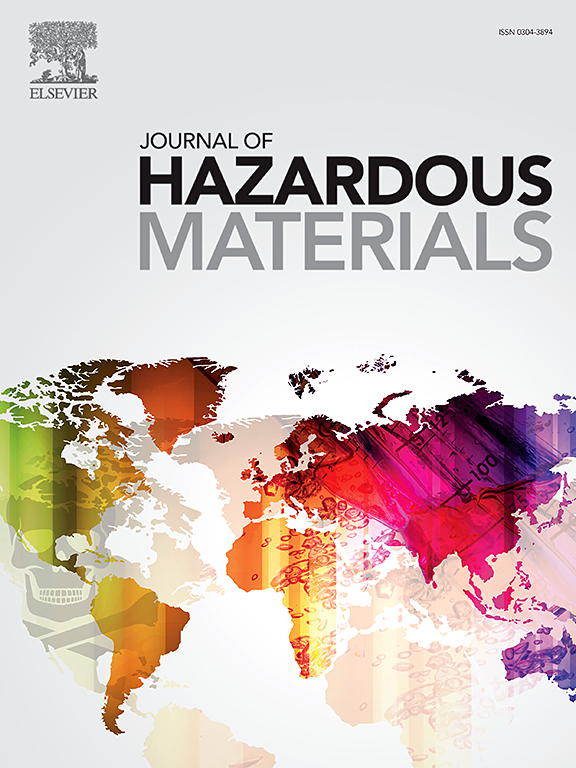Chiral naproxen enhances horizontal transfer of antibiotic resistance genes in biofilms: Molecular docking reveals stereoselective mechanisms
IF 11.3
1区 环境科学与生态学
Q1 ENGINEERING, ENVIRONMENTAL
引用次数: 0
Abstract
The dissemination of antibiotic resistance genes (ARGs) is a growing global health concern. This study investigates how the chiral enantiomers of the non-antibiotic drug naproxen (NAP) influence ARG dissemination in biofilms. Metagenomic sequencing and binning analyses revealed that NAP enantiomers selectively enriched ARGs and their bacterial hosts, enhancing resistance to specific antibiotics. Notably, the stereoselective effects of NAP enantiomers not only shaped microbial community composition but also affected the potential for ARG spread. Mechanistically, exposure to R-NAP, in comparison to S-NAP, resulted in a 1.53-fold increase in reactive oxygen species (ROS) production, an 18.20% enhancement in cell membrane permeability, and a 1.93-fold rise in the abundance of genes associated with the type IV secretion system (T4SS). These physiological and genetic changes promoted microbial aggregation and DNA conjugation, particularly enhancing the transfer of the sul1 gene within the Aquabacter genus through the coordinated action of T4SS, two-component systems (TCS), and quorum sensing (QS). Molecular docking and qRT-PCR analyses further revealed that the stereoselectivity of NAP enantiomers stemmed from their distinct binding interactions with proteins involved in horizontal gene transfer, shedding light on the molecular mechanisms underlying ARG dissemination under chiral NAP exposure.

手性萘普生增强生物膜中抗生素抗性基因的水平转移:分子对接揭示立体选择机制
抗生素耐药基因(ARGs)的传播是一个日益严重的全球卫生问题。本研究探讨了非抗生素药物萘普生(NAP)的手性对映体如何影响ARG在生物膜中的传播。宏基因组测序和分箱分析显示,NAP对映体选择性地富集ARGs及其细菌宿主,增强对特定抗生素的耐药性。值得注意的是,NAP对映体的立体选择效应不仅影响微生物群落组成,而且影响ARG传播的潜力。在机制上,与S-NAP相比,暴露于R-NAP导致活性氧(ROS)产生增加1.53倍,细胞膜通透性增加18.20%,与IV型分泌系统(T4SS)相关的基因丰度增加1.93倍。这些生理和遗传变化促进了微生物聚集和DNA结合,特别是通过T4SS、双组分系统(TCS)和群体感应(QS)的协同作用,促进了sul1基因在水藻属内的转移。分子对接和qRT-PCR分析进一步揭示了NAP对映体的立体选择性源于它们与参与水平基因转移的蛋白的不同结合相互作用,揭示了手性NAP暴露下ARG传播的分子机制。
本文章由计算机程序翻译,如有差异,请以英文原文为准。
求助全文
约1分钟内获得全文
求助全文
来源期刊

Journal of Hazardous Materials
工程技术-工程:环境
CiteScore
25.40
自引率
5.90%
发文量
3059
审稿时长
58 days
期刊介绍:
The Journal of Hazardous Materials serves as a global platform for promoting cutting-edge research in the field of Environmental Science and Engineering. Our publication features a wide range of articles, including full-length research papers, review articles, and perspectives, with the aim of enhancing our understanding of the dangers and risks associated with various materials concerning public health and the environment. It is important to note that the term "environmental contaminants" refers specifically to substances that pose hazardous effects through contamination, while excluding those that do not have such impacts on the environment or human health. Moreover, we emphasize the distinction between wastes and hazardous materials in order to provide further clarity on the scope of the journal. We have a keen interest in exploring specific compounds and microbial agents that have adverse effects on the environment.
 求助内容:
求助内容: 应助结果提醒方式:
应助结果提醒方式:


